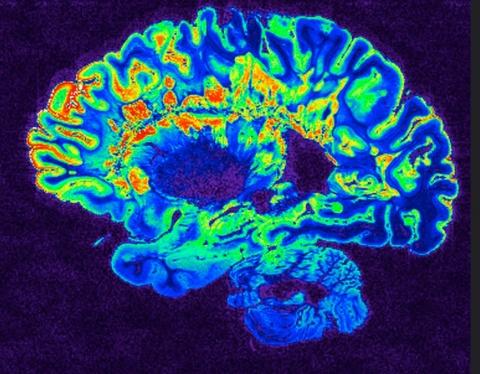
This June, members of the Duke Neurology Department contributed to 12 new peer-reviewed journal articles as well as two new book chapters. Among other findings these studies uncovered retinal differences that may one day act as early biomarkers for cognitive impairment, population-based studies that will improve treatment for stroke and other conditions, and investigations of hydrogel scaffolds as potential therapies. Read the paragraphs below for short summaries of each of these and other articles, and find links to the original articles themselves.
Stroke and Vascular Neurology
- Senior authors Jay Lusk and Michael “Luke” James, MD, as well as Daniel Laskowitz, MD, MHS, contributed to an exploratory cohort study comparing trends in neuroinflammatory biomarker levels in 18 consecutively enrolled patients with acute supratentorial intracerebral hemorrhage (ICH) and 16 patients treated with the investigational neuroprotective therapy CN-105 to identify a panel of 10 biomarkers. Their work provides some of the first insights into the longitudinal associations between markers of neuroinflammation and development of perihematomal edema and secondary tissue injury in human ICH. Read the article in the Journal of Stroke and Cerebrovascular Disease.
- Vagus nerve stimulation (VNS) is an invasive neuromodulation technique that offers the potential to enhance motor recovery after stroke by increasing motor networks’ neuroplasticity. Wuwei “Wayne” Feng, MD, MS, was the senior author of a study discussing recent clinical trials involving VNS as well as directions for future research. Read that article in Translational Stroke Research.
- Brian Mac Grory, MB BCh, MRCP, contributed to a cohort study that found that compared outcomes of endovascular therapy patients treated with and without alteplase, finding that treatment was alteplase was associated with greater likelihood of discharge to home, independent ambulation at discharge, and lower mortality, but higher risk of symptomatic intracranial hemorrhage. Read that article here.
- Brian Mac Grory, MB BCh, MRCP, contributed to an article examining blood pressure and LDL cholesterol levels in stroke survivors and controls from 1999 to 2018. The team found an early decrease in blood pressure as well as a consistent decrease in LDL cholesterol levels during this period, paralleling trends in stroke during this time, even as both levels remain higher than public health recommendations. Read the full article in Stroke: Vascular and Interventional Neurology.
Memory Disorders
- A new article in Retina provides important insights into retinal indicators of cognitive impairment. A team including Andrew Liu, MD, MS, Kim Johnson, MD, and colleagues from the Duke Department of Ophthalmology found that perfusion density in the retina’s 3-mm inner ring was significantly lower in amnestic mild cognitive impairment (MCI) patients when compared with nonamnestic MCI participants and controls with normal cognition. Read that article here.
Epilepsy, Sleep, and Neurophysiology
- Aatif Husain, MD, contributed to a new open label, phase-2 trial investigating intravenous ganaxolone for the treatment of refractory status epilepticus. The team found that the treatment achieved rapid and durable seizure control in patients with refractory status epilepticus, and also showed acceptable levels of safety and tolerability. Read that article in Epilepsia.
- Aatif Husain, MD, contributed to two chapters of the new edition of the Handbook of Clinical Neurology. The first is a chapter discussing the dorsal root entry zone procedure and other surgeries to manage chronic pain. Read that chapter here. Husain also contributed to a chapter reviewing intraoperative neuromonitoring. Read that chapter here.
Translational Brain Sciences
- Tatiana Segura, PhD, was the senior author of a new study investigating the potential for microporous annealed particle (MAP) scaffolds generated from assembled hydrogel microparticles as a future therapy for stroke. The team concluded that MAP hydrogels can be engineered to either promote neurogenesis or enhance stemness depending on the chosen post-modifications, which can be key in modulating their phenotypes in various applications in vivo. Read the full study in Advanced Materials.
- Spatial navigation and orientation are emerging as promising markers for altered cognition in prodromal Alzheimer’s disease, even in normal individuals at risk for Alzheimer’s disease. In the latest issue of Frontiers in Neuroscience, first author Alexandra Badea, PhD, Carol Colton, PhD, and colleagues introduce a new metric, the absolute winding number, to characterize the spatial search strategy, which better differentiated APOE3 carriers, through their straighter swim paths relative to both APOE2 and APOE4 genotypes. This novel metric supported increased vulnerability in APOE4 females. Read that article here.
- Yong Chen, PhD, was part of a new eLife study uncovers the functional expression of TRPV4 and one of the physiological activation mechanisms of TMEM16F in human trophoblasts. Their research will provide novel strategies to regulate CaPLSase activity as a critical checkpoint of physiologically- and disease-relevant cell fusion events. Read it here.
- The Bryan Brain Bank’s John Ervin contributed to a compilation of 13 high-quality community- and population-based longitudinal studies examining the frequency of LATE neuropathologic change across the spectrum of Alzheimer's disease neuropathology. Read that article in Acta Neuropathologica.
- Alexandra Badea, PhD, was the senior author of a study that compared four different MRI protocols to segment ischemic stroke lesions. Their results suggest that multi-contrast information enhanced the accuracy of the segmentation, and the prediction accuracy for upper extremity motor outcomes. Wuwei “Wayne” Feng, MD, MS, contributed to the study, which appeared in Magnetic Resonance Imaging. Read it here.
Neuromuscular Disease
- Don Sanders, MD, was the senior author of a new monograph describing and comparing two methods for recording jitter: the single fiber electromyography method as well as the more recently developed method of recording jitter with concentric needle electrodes. Read that monograph in Muscle and Nerve.
- Lisa Hobson-Webb, MD, contributed to a new review of methods used in musculoskeletal soft tissue and nerve shear wave elastography studies. The team’s analysis of nearly 400 shear wave studies found high methodological heterogeneity as well as a lack of information on depth of measurement or use of surface electromyography. Read that article here.